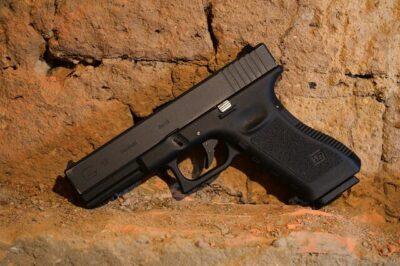Most of today’s striker-fired pistols, like Glock, Smith & Wesson’s M&P line, Springfield Armory’s XD series, and others, are made to be easy to “take down,” or disassemble for cleaning. Despite that, I often encounter new owners of these guns who’ve never cleaned it for fear of doing something wrong.
This is the five-minute routine I do after a long day on the range when my gun is headed to storage for a while, after my gun’s been in damp or wet weather, or for a student who brings a dry, dirty, or brand new gun to class and is having problems. It’s not my aim to neglect what an owner’s manual says, but a quick cleaning is better than nothing.
Supplies
If you’re pregnant, nursing, or have open cuts on your hands, wear rubber gloves. If you choose to go glove-less, at least wash your hands at the end of this process. The responsibility for preventing toxin exposure lies with you.
A scrap of a clean T-shirt and a bottle of CLP (cleaner, lubricant and protectant) are my go-to supplies. Frog Lube is my favorite CLP; it’s non-toxic and even smells nice. Extreme Force Weapons Lube is a new CLP that may work better for folks who use their gun in extreme cold. Both Frog Lube and Extreme Force are American products.
The Self-Defense And Hunting Weapon That Doesn’t Require A Firearms License!
One thing you should NOT have is ammunition. Start with a gun that’s completely unloaded — magazine out, chamber clear. Ammunition should not be within arm’s reach of your cleaning station. Many unintended, sometimes tragic discharges occur at cleaning time.
The Task
The order of parts described here isn’t necessary. Pick your own order.
Disassemble your pistol and lay the parts on a relatively clean surface. Pick up the slide, put a dot of CLP on the rag, and wipe out the entire visible interior surface. Be sure to take a fingernail (or other similarly shaped object, like a flat screwdriver head), and run the dampened rag through the grooves along the length of the slide’s interior. This is a place where gunk builds up. Once the rag is coming up from the grooves clean, put a fresh drop or two of CLP on each groove and smear it in with a fingertip.
Now, pick up the recoil spring/guide rod. Wipe both ends using a clean section of the rag. Wrap the spring/rod unit inside the rag and turn it in your tightly closed palm. No lube is needed here.
The barrel is next. With the rag moistened with CLP, rub the entire outer surface with pressure, getting off all the buildup. The feed ramp of the barrel is an important place to clean. There’ll be some buildup here, even if you’ve only fired a few rounds. Wipe hard until it looks smooth. Depending on your barrel’s composition and finish, it may become shiny like chrome. Wipe the feed ramp dry.
Do the same around the locking lugs. Basically, any place on the barrel with sharp angles will have carbon accumulation. Get it off to insure your pistol continues to function smoothly.
If you’ve neglected cleaning, fired a lot of +P ammo, or have been rolling in the dirt, the accumulated gunk may be stubborn. A nylon bristle brush like an old toothbrush, cleaned and dried, works great for such occasions. But that’s beyond the five-minute rule. A partial cleaning beats neglect!
Notice I didn’t talk about cleaning the barrel interior. At least take a look through the bore for any abnormal accumulations or damage. If you feel you must clean it, a dry patch or Bore Snake is more than sufficient for a quick cleaning. The bore and feed ramp do not require oil.
Put one or two drops of CLP on the outside of the barrel, and smooth it all around with your finger, avoiding the feed ramp and muzzle ends. This is a high-friction, high-heat surface.
On the frame, give the locking block and exposed parts of the trigger mechanism a wipe-off with a dry rag. If you’re not sure which parts are which, just wipe off the metal parts you can see.
Finally, use the rag to clean the rails on each side of the frame. These match up with the grooves on the inside of the slide. Put a dab of CLP in each rail, and spread it along the rails’ length.
All Done!
Reassemble your pistol. If any excess lube is seeping out the sides, wipe it off. Give the outside of the slide a wipe-down to remove fingerprints and any remaining smudges.
That’s it — doing it takes a fraction of the time reading this did! Don’t forget to wash your hands in cool water if you’re like me and do this job bare-handed.
A Word on New Products
Conventional wisdom has held that we never oil the bore. Especially in a firearm that’s carried or stored with a round in the chamber, it is possible that oil will penetrate the cartridge, causing a misfire or dangerous squib (insufficient pressure resulting in a bullet that’s stuck in the barrel).
Technology has a way of running contrary to conventional wisdom at times. A couple of new firearm oils are made for use in the bore. In rifles, there is evidence that the behavior of these products, on a molecular level, results in increased precision, i.e., smaller shot groups. For a striker-fired pistol, accuracy gains caused by oil are likely to be undetectable. While I have used new barrel oils from Modern Spartan Systems and the Hoppe’s Black line, keep in mind these products were made for rifles, not pistols. Use these products sparingly inside the bore if you use them, and swab them well so that no visible oil remains in the barrel when it’s time to reassemble the firearm.
Do you have any gun-cleaning tips? Share them in the section below:
 Off The Grid News Better Ideas For Off The Grid Living
Off The Grid News Better Ideas For Off The Grid Living





